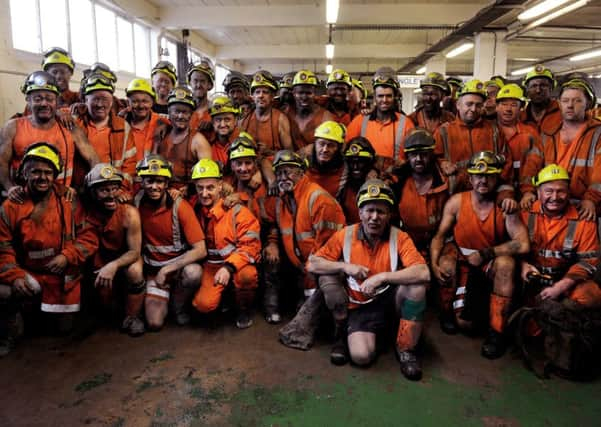Tony Lodge: Old King Coal is dead, but long live British mining


For a number of years, the sector had been unable to compete with cheap imports and rising carbon taxes which penalised coal’s biggest market in the power stations. Generating electricity by burning coal is likely to have ended in Britain by the early 2020s as it is now deemed environmentally unacceptable. So this is the end for coal in Britain. Isn’t it?
Many with a history in coal mining, or with family who worked in the industry, will tell you that not all coal is the same. There are many varieties, each with different uses, alongside the traditionally favoured thermal coal which is used in power stations to generate electricity. This ‘thermal coal’ type was always the priority for the old National Coal Board with its large and hungry electricity generating customers with their once numerous coal-fired plants.
Advertisement
Hide AdAdvertisement
Hide AdA good example was Selby, where Britain’s last major coalfield was sunk. Six separate mines, joined together, started production in 1983. This had taken a decade and £1.4bn (£4.5bn today) to get into full production. Over 20 years, 121 million tonnes of thermal coal, accessed by 460 miles of underground roadway, was recovered. It supplied the power stations at Drax, Eggborough and Ferrybridge from an underground coal resource the size of the Isle of Wight. The Selby complex closed in 2004.
Importantly, other types of higher grade coal were also produced for other industries; these had markets in manufacturing, in particular the steel and related industries. It is this large market, for high quality ‘coking’ coal which is used to make steel, that looks set to underpin, and deliver, Britain’s first new deep coal mine for a generation.
One of Britain’s most unique coalfields is located on the Cumbrian coast where colliery winding towers looked out over the Irish Sea. The last deep mine, Haig Colliery, closed in 1986. This area around Whitehaven and Workington was well known in Yorkshire, not only as home to fellow miners but because of the deep rivalry which existed on the rugby pitch. The towns had well-supported rugby league teams; Whitehaven recorded their highest ever match attendance when they played Wakefield Trinity in a 1960 cup match, attracting nearly 19,000 fans.
There is now a well-progressed plan to mine the high quality coking coal resource and supply it to the recovering British and European steel markets. West Cumbria Mining has gained significant local support since 2014 and is aiming to create over 500 skilled jobs as part of a £185m proposal to develop a new underground mine extracting coal offshore. Saleable annual coal output is forecast to reach 2.5 million tonnes; in comparison Kellingley Colliery averaged just under two million tonnes a year.
Advertisement
Hide AdAdvertisement
Hide AdThis distinction between thermal coal and coking coal is very important. Where thermal coal in Britain appears to have no future, more specialist coals do have longer-term sustainable markets.
The Cumbria plans are just one of a number of other new mining proposals in Britain. In North Yorkshire the £2.4bn proposal by Sirius Minerals to mine a new form of potash under the North York Moors National Park has made significant progress, having recently being awarded planning approvals. This involves the mining and processing of the world’s largest polyhalite resource, which is used as a fertilizer for plant growth. The developers say it will provide a boost to global agriculture and aim to produce 10 million tonnes a year. The plan could create up to 2,500 direct and indirect jobs and will consist of a new deep mine (1,500m) three miles south of Whitby.
There are also serious moves to look again at mining tin and other metal deposits in Cornwall. New investment plans at the mothballed South Crofty mine near Camborne could see 200 employed and full production restarted by 2020, while a long-forgotten deposit at Redmoor is now being actively investigated, together with the fully operational open pit tungsten mine which Wolf Minerals opened in 2015.
I was underground at one of Britain’s last thermal coal mines at Hatfield near Doncaster just before it closed in 2015. It had been operating for 100 years and was increasingly uneconomic. It was the closing of a chapter. But new mining projects, whether they be to extract high grade specialist coal, rare potash or metals such as tin, deserve and need better regulatory support from the Government. This should go in parallel with the kind of support being offered to the controversial shale gas sector.
Advertisement
Hide AdAdvertisement
Hide AdAfter all, these are private companies prepared to accept all of the risks which go with any large new mining project. Importantly, they can generate new skilled jobs outside London and the South East and provide work for former miners. They will also boost their regional economy, creating a large skills chain.
With the right support, Britain can enjoy a new chapter in extracting its rich and varied mineral resources in the national interest. This, in turn, can allow for a reinvigorated British export sector supplying hungry customers around the world. In the post-Brexit world, such projects are more vital and welcome than ever.
Tony Lodge is a Research Fellow at the Centre for Policy Studies.